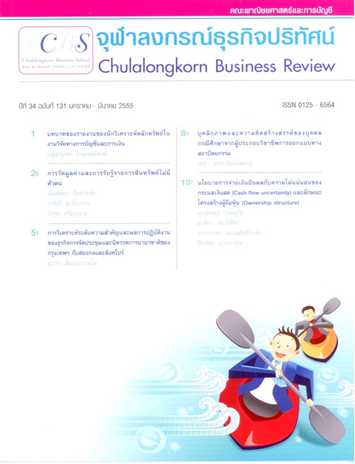นโยบายการจ่ายเงินปันผลกับความไม่แน่นอนของกระแสเงินสด (Cash flow uncertainty) และลักษณะโครงสร้างผู้ถือหุ้น (Ownership structure)
Main Article Content
Abstract
บทคัดย่อ
งานศึกษานี้มีวัตถุประสงค์เพื่อหาปัจจัยที่กำหนดโอกาสและอัตราการจ่ายเงินปันผลของบริษัทจดทะเบียนในตลาดหลักทรัพย์แห่งประเทศไทย โดยรวบรวมตัวแปรจากทฤษฎีต่าง ๆ ที่เกี่ยวข้องได้แก่ ทฤษฎีการส่งสัญญาณ (Signaling theory), ทฤษฎีตัวแทน (Agency theory), ทฤษฎีอายุของกิจการ (Life-cycle theory), ทฤษฎีต้นทุนการทำธุรกรรม (Transaction cost theory) และ ทฤษฎีโอกาสในการเติบโต (Growth opportunity theory) โดยให้ความสำคัญเป็นพิเศษกับสองปัจจัย คือ ความไม่แน่นอนของกระแสเงินสด และ ลักษณะโครงสร้างผู้ถือหุ้น อันได้แก่ สัดส่วนการถือหุ้นของผู้ถือหุ้นรายย่อย, สัดส่วนการถือหุ้นของผู้ถือหุ้นรายใหญ่ และ สัดส่วนการถือหุ้นโดยต่างชาติ การศึกษาใช้เทคนิค Probit model, Tobit model และ Random effects model ในการศึกษาข้อมูลบริษัทจดทะเบียนจำนวนกว่า 330 บริษัท ในช่วงระยะเวลาระหว่างปี 2545 ถึง 2552
ผลการศึกษาพบว่า ความไม่แน่นอนของกระแสเงินสดมีผลกระทบต่อการตัดสินใจจ่ายเงินปันผลเท่านั้น แต่กลับไม่มีผลต่ออัตราการจ่ายเงินปันผล โดยบริษัทที่มีกระแสเงินสดไม่แน่นอนจะมีโอกาสจ่ายเงินปันผลน้อยกว่าบริษัทที่มีกระแสเงินสดสม่ำเสมอ ส่วนด้านโครงสร้างผู้ถือหุ้น ผลการศึกษาพบว่า สัดส่วนการถือหุ้นโดยผู้ถือหุ้นต่างชาติเป็นปัจจัยที่เพิ่มโอกาสการจ่ายเงินปันผล กล่าวคือ บริษัทที่มีการถือหุ้นโดยต่างชาติสูง บริษัทก็มีโอกาสจ่ายเงินปันผลสูงเช่นกัน แต่สัดส่วนการถือหุ้นโดยผู้ถือหุ้นต่างชาตินี้กลับไม่มีผลต่ออัตราการจ่ายเงินปันผล ในขณะที่ สัดส่วนการถือหุ้นโดยผู้ถือหุ้นรายย่อยกลับเป็นปัจจัยที่ลดทั้งโอกาสการจ่ายเงินปันผลและอัตราการจ่ายเงินปันผล ส่วนสัดส่วนการถือหุ้นโดยผู้ถือหุ้นรายใหญ่ไม่มีผลต่อทั้งโอกาสและอัตราการจ่ายเงินปันผล
ผลการศึกษายังพบอีกว่า อายุของกิจการ และ สภาพคล่องในการซื้อขาย เป็นอีกปัจจัยที่มีผลต่อการตัดสินใจว่าบริษัทจะจ่ายเงินปันผลหรือไม่ โดยบริษัทที่มีอายุกิจการมากขึ้นจะมีโอกาสจ่ายเงินปันผลมากขึ้น สอดคล้องกับทฤษฎีอายุของกิจการ ในขณะที่บริษัทที่หุ้นของตนเองมีสภาพคล่องในการซื้อขายสูงจะมีโอกาสจ่ายเงินปันผลน้อยลง สอดคล้องกับทฤษฎีต้นทุนการทำธุรกรรม อย่างไรก็ดี ในด้านปัจจัยที่กำหนดอัตราการจ่ายเงินปันผลพบว่า มีเพียงสภาพคล่องในการซื้อขายเท่านั้นที่มีผลต่ออัตราการจ่ายเงินปันผล โดยบริษัทที่หุ้นของตนเองมีสภาพคล่องในการซื้อขายสูงจะจ่ายเงินปันผลในอัตราที่ลดลง สอดคล้องกับทฤษฎีต้นทุนการทำธุรกรรม
คำสำคัญ : เงินปันผล นโยบายการจ่ายเงินปันผล ความไม่แน่นอนของกระแสเงินสด โครงสร้างผู้ถือหุ้น ทฤษฏีการส่งสัญญาณ ทฤษฎีตัวแทน ทฤษฎีอายุของกิจการ ทฤษฎีต้นทุนการทำธุรกรรม ทฤษฎีโอกาสในการเติบโต
Abstract
The objective of this study is to investigate factors that affect decision to pay dividend and dividend payout ratio of listed company in Thailand. Factors are chosen from relevant theories which include Signaling theory, Agency theory, Life-cycle theory, Transaction cost theory and Growth opportunity theory. Cash-flow uncertainty and shareholding structure, such as foreign ownership, large shareholder ownership, and minority ownership, are studied in depth in this research. The method used are Probit model, Tobit model, and Random/Fixed effects model. Approximately 330 listed companies in Thailand during year 2002 to 2009 are covered in this study.
From our evidence, Cash-flow uncertainty influences dividend payment decision but not a payout ratio. Concerning shareholding structure, the result shows that foreign ownership increases probability to pay dividend. However, foreign ownership has no impact on payout ratio. Minority ownership negatively influences both dividend payment decision as well as dividend payout ratio. Interestingly, large shareholder ownership has no impact on both dividend payment decision and dividend payout ratio.
Both company’s life-cycle stage and stock liquidity are important factors in determining whether a listed company would pay a dividend. This study finds that mature company has a higher propensity to pay dividend as predicted by Life-cycle theory. Moreover, this study also finds that a listed company whose stock is liquid would have a lower chance to pay dividend or has a lower dividend payout ratio as predicted by Transaction cost theory.
Keywords : Dividend, Dividend Policy, Cash Flow Uncertainty, Ownership Structure, SignalingTheory, Agency Theory, Life-Cycle Theory, Transaction Cost Theory, Growth OpportunityTheory
Article Details
Opinions and discussions in papers published by the Creative Business and Sustainability Journal (CBSJ) are deemed as personal opinions and the responsibility of the writers. They are not the opinions or responsibility of the Chulalongkorn Business School of Chulalongkorn University.
Papers, content, information etc. appearing in the Journal are deemed to be the copyright property of the Chulalongkorn Business School of Chulalongkorn University. Anybody or any organization that wishes to publish any part of them or use them in any way must obtain written permission from the Chulalongkorn Business School, Chulalongkorn University.


